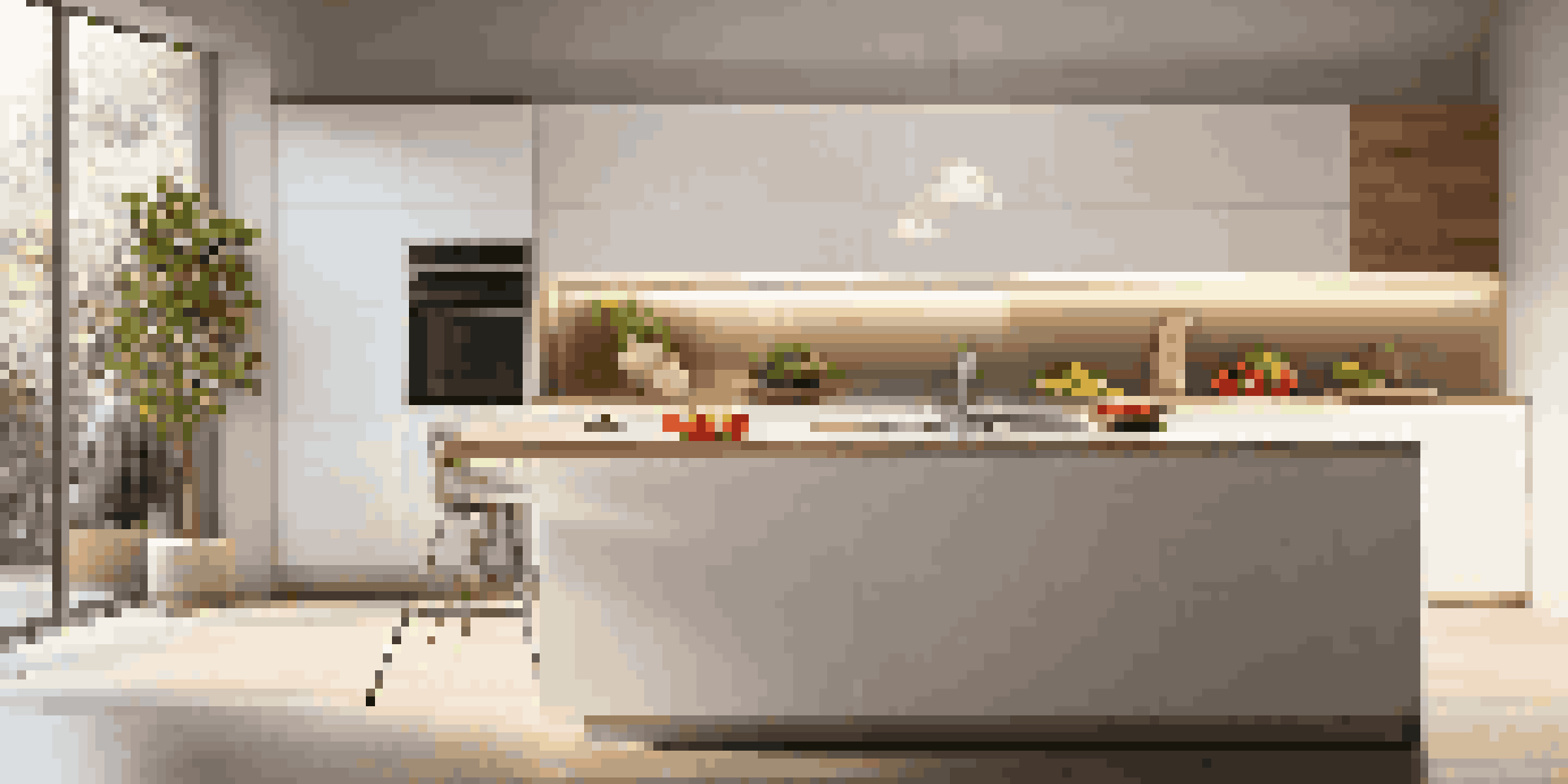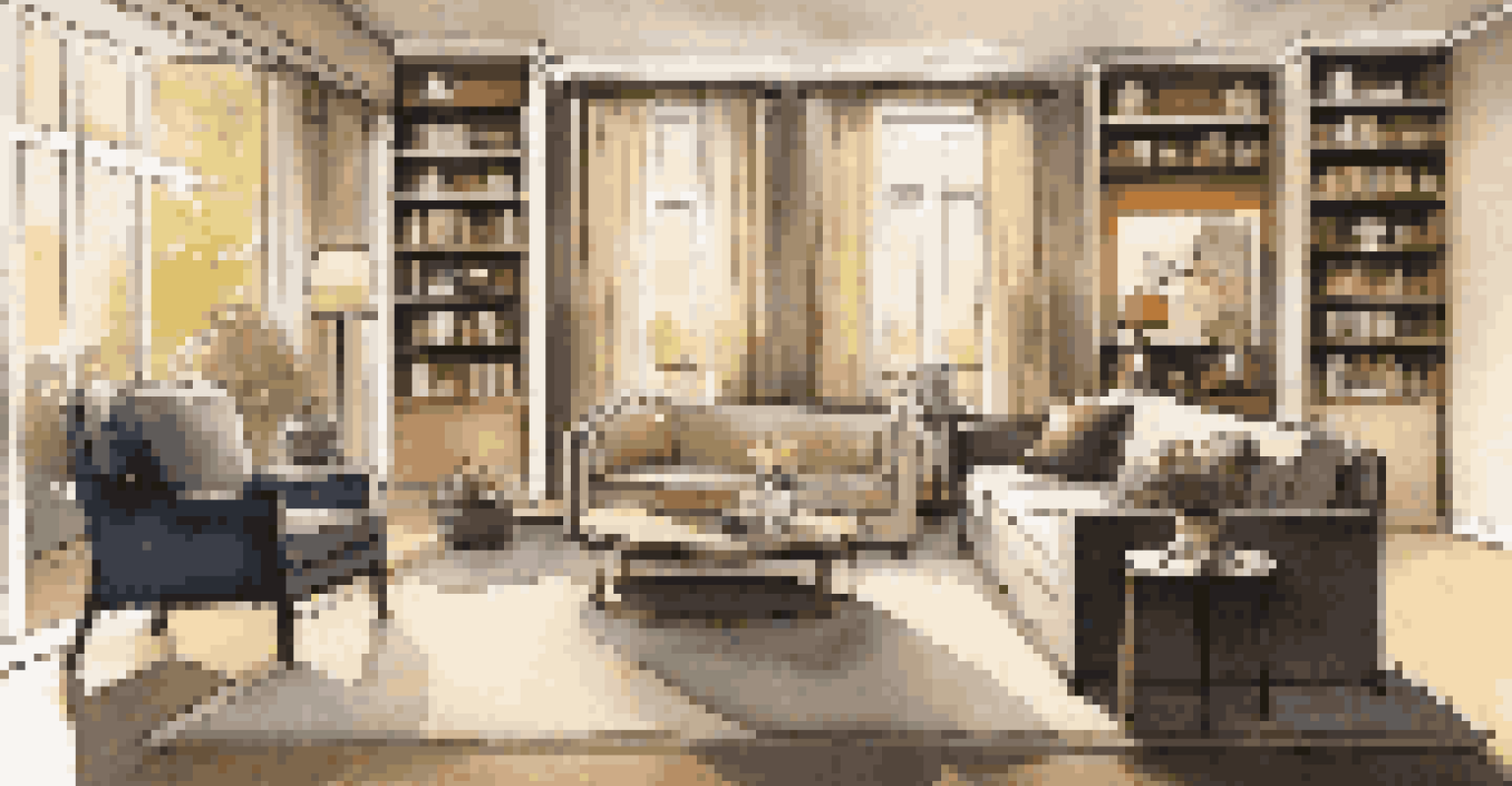Incorporating LED Lighting for Modern Home Design Solutions

Understanding the Benefits of LED Lighting in Homes
LED lighting has revolutionized modern home design, offering energy efficiency and longevity. Unlike traditional bulbs, LEDs use a fraction of the energy, which can significantly reduce electricity bills. This makes them an environmentally friendly choice, appealing to eco-conscious homeowners. Additionally, they last much longer, often up to 25 times more than incandescent bulbs, which means less frequent replacements and waste.
Lighting is a vital part of the design and construction of any home. A well-designed lighting plan can transform a dull space into a vibrant one.
Another major advantage of LED lighting is its versatility in design. With various shapes, sizes, and colors, LEDs can fit seamlessly into any decor style, from minimalist to eclectic. This adaptability allows homeowners to experiment with different lighting schemes that can dramatically alter the mood and ambiance of a space. Whether you want a warm glow for a cozy living room or bright white light for a functional kitchen, LEDs can provide the perfect solution.
Finally, LED technology is constantly evolving, leading to exciting new features like smart lighting. With smart LED systems, homeowners can control brightness and color temperature through their smartphones or voice-activated devices. This level of control not only enhances convenience but also allows for creative expression in home design, making it easy to change the atmosphere of a room at the touch of a button.
Creating Ambiance with LED Lighting Techniques
Creating the right atmosphere in your home often hinges on effective lighting. LED lights can be used to highlight architectural features, artworks, or even specific areas within a room. By strategically placing LED strips under cabinets or along shelves, you can create a soft glow that enhances the aesthetic appeal without overwhelming the senses. This layered approach to lighting can make your space feel more inviting and luxurious.

Moreover, color temperature plays a crucial role in setting the mood. Warm white LEDs (around 2700K) provide a cozy and relaxed vibe, ideal for living rooms and bedrooms. On the other hand, cooler temperatures (5000K and above) are perfect for workspaces as they promote focus and alertness. By mixing different color temperatures, you can tailor your home’s lighting to fit various activities and times of day.
LEDs Save Energy and Costs
LED lighting consumes up to 75% less energy than traditional bulbs, leading to lower electricity bills and a reduced environmental impact.
Lastly, dimmers can elevate your LED experience even further. Using dimmable LED lights allows you to adjust the brightness according to your needs, whether you’re hosting a dinner party or enjoying a quiet movie night. This flexibility not only conserves energy but also enhances the overall design by allowing the space to adapt to different occasions.
Incorporating LED Lighting into Different Rooms
When it comes to kitchen design, LED lighting can serve both functional and aesthetic purposes. Under-cabinet LED lighting illuminates countertops, making meal prep safer and more efficient. Pendant lights with LED bulbs above islands or dining areas can also add a stylish touch, creating a focal point that draws the eye and enhances the overall design.
Energy efficiency is not just about saving money; it's about creating a sustainable future for our planet.
In the bedroom, soft LED lighting can transform the space into a serene retreat. Consider using LED strip lights behind the headboard or around the perimeter of the ceiling for a gentle glow that promotes relaxation. Additionally, bedside lamps equipped with LED bulbs can provide sufficient lighting for reading without being harsh on the eyes.
Living rooms are another area where LED lighting can shine, literally and figuratively. From LED recessed lighting to stylish floor lamps, there are endless options to create a striking visual impact. Incorporating LED lights into bookshelves or entertainment units can add depth and character to the room, making it a cozy gathering space for family and friends.
Energy Efficiency and Sustainability of LED Lighting
One of the most compelling reasons to switch to LED lighting is its energy efficiency. LEDs consume significantly less power than traditional incandescent bulbs, often using up to 75% less energy. This not only translates to lower electricity bills but also less stress on the environment, which is a crucial consideration in today’s world of climate change and resource depletion.
The longevity of LED lights also contributes to their sustainability. With an average lifespan of 15,000 to 25,000 hours, they reduce the frequency of replacements and the waste associated with burnt-out bulbs. This durability means fewer resources are consumed in manufacturing and transportation, making LEDs a responsible choice for eco-friendly homes.
Versatile Design for Any Room
LED lights come in various shapes and colors, allowing homeowners to creatively enhance the ambiance and aesthetic appeal of different spaces.
Additionally, many LED lights are now made using recyclable materials and are free from toxic substances such as mercury, commonly found in fluorescent lights. This commitment to sustainability makes LED lighting not only a smart choice for your home but also a responsible choice for the planet.
Smart Home Integration with LED Lighting
The rise of smart home technology has opened up a world of possibilities for LED lighting. Smart LED bulbs can be controlled remotely, allowing you to adjust brightness, color, and schedules from your smartphone or voice-controlled devices. This level of convenience means you can create the perfect ambiance with just a few taps or voice commands, no matter where you are in your home.
Integration with home automation systems takes this a step further. For example, you can program your LED lights to mimic your presence when you’re away, enhancing security. Setting timers and routines can make your life easier while ensuring your home is always well-lit when you need it.
Moreover, smart LED technology often includes energy monitoring features, helping homeowners track their energy consumption. This data can encourage more mindful usage, contributing to both savings and sustainability. The combination of smart technology and LED lighting is a match made in modern home design heaven.
LED Lighting as a Design Element
In modern home design, LED lighting is not just a functional necessity; it's also a critical design element. Designers increasingly use LED features to create stunning visual effects and architectural highlights. From backlit mirrors in bathrooms to illuminated pathways in outdoor spaces, the creative application of LED lighting can elevate any design project.
LED lighting can also enhance the texture and colors in a room. By using colored LEDs, you can accentuate specific design features, creating a lively atmosphere. For instance, using blue or green hues can evoke a sense of calm and tranquility, perfect for a spa-like bathroom or a relaxing bedroom retreat.
Future Innovations in LED Lighting
Advancements in LED technology, such as smart home integration and tunable white lights, promise even greater energy efficiency and customization for modern homes.
Furthermore, the use of LED lighting can help in zoning spaces. In an open-concept layout, different lighting schemes can delineate areas for cooking, dining, and lounging without the need for physical barriers. This thoughtful use of light can make your home feel more organized and inviting.
The Future of LED Lighting in Home Design
As technology continues to advance, the future of LED lighting in home design looks incredibly promising. Innovations such as tunable white lights, which can change color temperature throughout the day, are becoming more accessible and popular. This feature allows homeowners to mimic natural daylight, improving mood and well-being while reducing the need for additional lighting.
Moreover, the integration of LEDs with renewable energy sources, such as solar panels, is paving the way for homes that are not only energy-efficient but also self-sustaining. This trend aligns perfectly with the growing demand for sustainable living solutions, making LED lighting an essential component of future home designs.

Lastly, as smart home technology progresses, we can expect even more intuitive and interconnected lighting solutions. Future developments may allow for greater customization and automation, ensuring that your home lighting adapts seamlessly to your lifestyle. With endless possibilities on the horizon, LED lighting is set to remain at the forefront of modern home design.